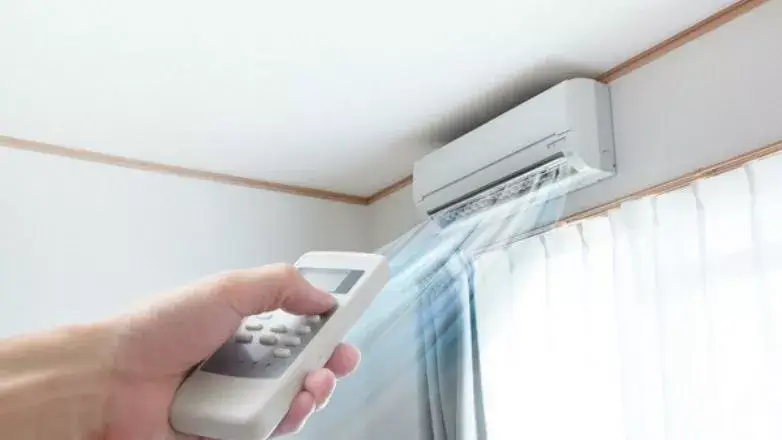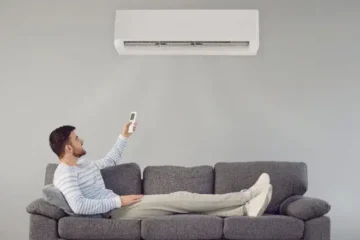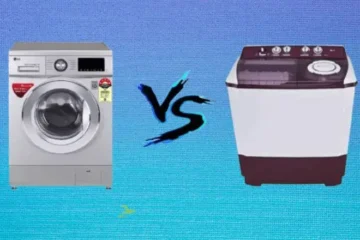Least to say, the working of AC defines as to change the temperature, humidity or general quality of the air. But How Does AC Temperature Work?
At times, we tend to find people asking questions such as: “Can I use my AC to cool two rooms?”, or “Why is it taking so much time for the temperature to come down?”, or “How split ac works or split air conditioning mechanism?” or “Why is right-sizing of an AC so important before making a purchase?”.
These questions are quite justified because people are made to understand how does an Air Conditioner works in a very technical manner with 4 component diagrams of:
- Compressor
- Condenser
- Expansion Device
- Evaporator
But before jumping on further, let’s pop up a balloon which says AC generates cooling on how does an Air Conditioner make the air cooler.
No, an Air Conditioner just makes your home cooler, by taking heat energy out of the house and throwing that heat to the outdoors.
Table of Contents
How Does the AC Temperature Work? Working of Air Conditioner
About Refrigerant Behind Working of Air Conditioner:
Basically, the working of Air Conditioner involves 4 major components along with a special compound said to be refrigerant or the coolant, which is of vital importance.
The refrigerant in an Air Conditioner undergoes the principle of phase change i.e. converting the liquid into gas & vice versa, again & again in a closed cycle of coils.
| COOL IN AN ECO-FRIENDLY WAY: Over the last few decades as a result of environmental concerns, the chemical composition of modern refrigerant compounds have changed. CFC R-12 gases have been banned; HCFC R-22 gases would get obsolete in the next 4-5 years. Eco-friendly HFC gases like R32, R134, R410A are highly recommended for use. |
Important Components or Parts of an Air Conditioner:
The Air Conditioners available in the market could be of window installed type is known as Window AC or portable split type which can be installed at any corner of the room commonly called Split AC. However, with the two categories of AC, the 4 basic components involved in the working of Air Conditioner remains quite the same, which includes:
1. Evaporator:
Basically, it is a heat exchanger that works in absorbing and transferring the heat from one medium to another medium, involved behind the working of Air Conditioner. An evaporator is located in the indoor unit. Particularly, it consists of coils that have cool refrigerant running it. The hot air from the room comes in its contact, to transfer the heat to the refrigerant making it hot into gas.
2. Compressor:
Undoubtedly, as the name suggests the prime work of the compressor during the working of Air Conditioner is to compress the refrigerant which increases or raises its temperature enabling the flow of coolant/refrigerant further ahead. It is located in the outdoor unit of AC. Further, the compressor of the AC is of high importance, it is the compressor that decides whether the AC is Inverter tech or Normal AC.
3. Condenser:
This is the second heat exchanger involved in the working of the Air Conditioner. Here, the vaporized and compressed refrigerant from the compressor comes with the heat in it which has to be taken off. It is located in the outdoor unit where the air is circulated or forced around it for cooling the refrigerant back into liquid form.
4. Expansion Valve:
This intermittent valve or device is located between the condenser coils and evaporator coils, that throttles or keeps a check on the amount of refrigerant to be passed from condenser to evaporator. Basically, the higher the refrigerant flow faster would be the cooling and vice versa.
NOTE: When talking about the Window AC the 3 previously stated components are placed in the small metal space in the window opening area.
The General Circuit Diagram Of AC Mechanism:
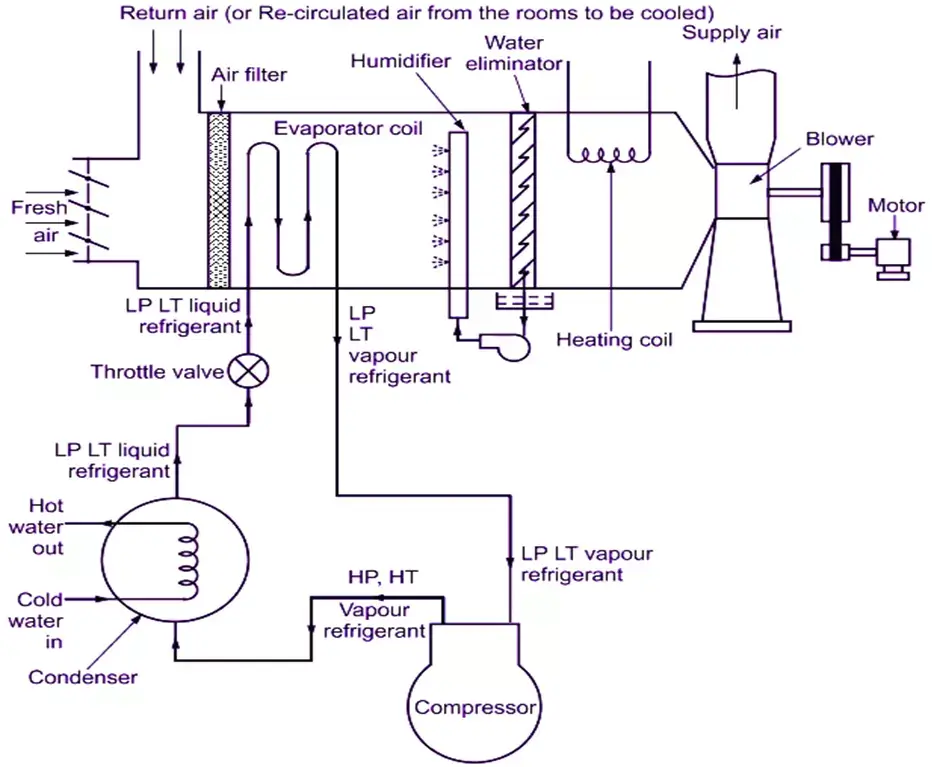
Behind Working Of Air Conditioner:
Initially, in the working of air conditioning, the refrigerant which is in the cool liquid state, it’s flow is regulated from the expansion device into the evaporator coils. Both of these components are parts of the indoor ac unit.
Once the refrigerant reaches the evaporator coils, it picks up the heat from the air inside the room. Air conditioners contain fans that move warm interior air over these cold, refrigerant-filled coils.
As a result, the refrigerant absorbs the heat from the air and turns from a liquid to a vapor. Hence, it changes from being a cold liquid to a hotter vapor. At the same time, the air had the heat removed from it, so the air went from being warmer to cooler.
This vapor refrigerant then passes through the compressor, which is in the ac outdoor unit. As the name suggests, the compressor compresses this vaporized refrigerant into the high-pressure coolant. Hence, while doing this the temperature of the refrigerant rises.
In order, to keep the cooling effect and process flowing, it is necessary to convert this high-temperature coolant again into its cold state. For this, the high-pressure & high-temperature coolant passes through the condenser coils, which is in the outdoor unit only.
A set of condenser coils and a second fan radiates all the extra heat formed during compression. Outdoor units often have metal fins on them to help dissipate the heat more quickly by increasing the surface area for the air to flow through.
The cool liquid coolant is now ready at the expansion device for it to pass through the evaporator coils again. This completes the generally closed circuit for how Air Conditioners work.
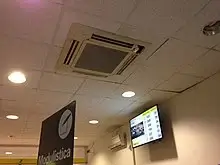
Additional Aspects In on How Does AC Temperature Work?
Simply just cooling the air isn’t the AC mechanism nowadays. Keeping the air free of humidity & improving the quality of air is also part of the complete process too.
For the entire working of Air Conditioner to run smoothly, few other aspects come into the picture.
1. Thermostat:
Chiefly, it helps to monitor and regulate the temperature of the room. Through sensors, it commands the compressor to shut off on reaching the desired temperature. Hence, this tends to play a great role in working on an inverter compressor for energy savings.
2. Moisture Traps & Dehumidifiers:
To keep the environment inside more comfortable, the Air Conditioner works also to dehumidify the air.
Temperature is a major component of relative humidity. Hence, reducing the temperature of a volume of humid air causes it to release a portion of its moisture.
In simple terms, behind the working of Air Conditioner, as the air moves across the evaporator coil, the coil absorbs heat and also takes out moisture. The air now has a cooler temperature and is drier. As a result, when it comes out, it mixes with inside air and thus makes the room more comfortable.
At last, all that water taken out of the air drains out from the unit. Hence, it clears, why Air Conditioner discharge water when they operate, especially on humid days.
3. Filters:
With the environmental concerns growing, the air nowadays is getting more accumulated with harmful dust particles, pollens, particulates, hairs, dander & other minute particles. Air filters in the ACs such as PM 2.5 filter, Electrostatic Dust filters, or Silver Ion filters helps to filter the impurities out. Thus, thereby keep the inside air fresh, clean & hygienic.
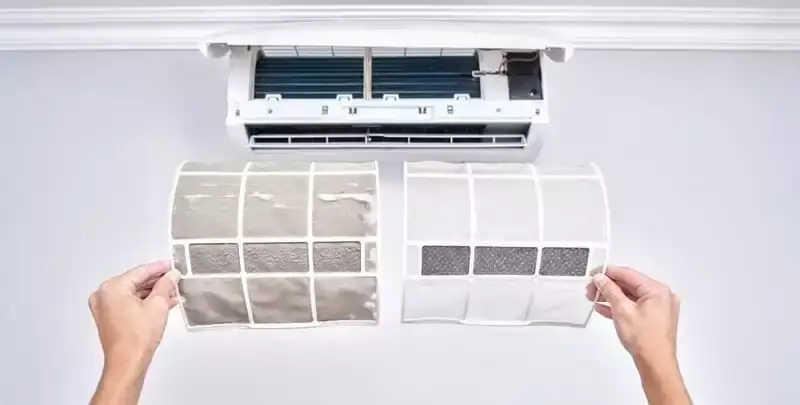
4. Blue Fin / Gold Fin Coating Technology:
Copper & Aluminum are the most considerable elements which are widely used for the condenser coils in the working of Air Conditioners. However, it has to be due noted that there is a huge probability of these coils getting damage due to rust, corrosion & humidity leading to poor performance and working of Air Conditioner.
As a result, certain technologies have been devised to combat these issues to enhance the durability of the coil & longer life of the Air Conditioner as well. The 2 common known methods of coating the coils include:
- Blue Fin Coating
- Gold Fin Coating
Blue Fin Technology:
Basically, in this hydrophilic blue epoxy anti-corrosive material is applied over the coil surface that prevents the accumulation of water droplets, acidic salts, or dust particles on them. As a result, it protects the coil from the damages of corrosion and increases the efficiency of the cooling process. thus, it is a widely recommended technology for the coastal areas.
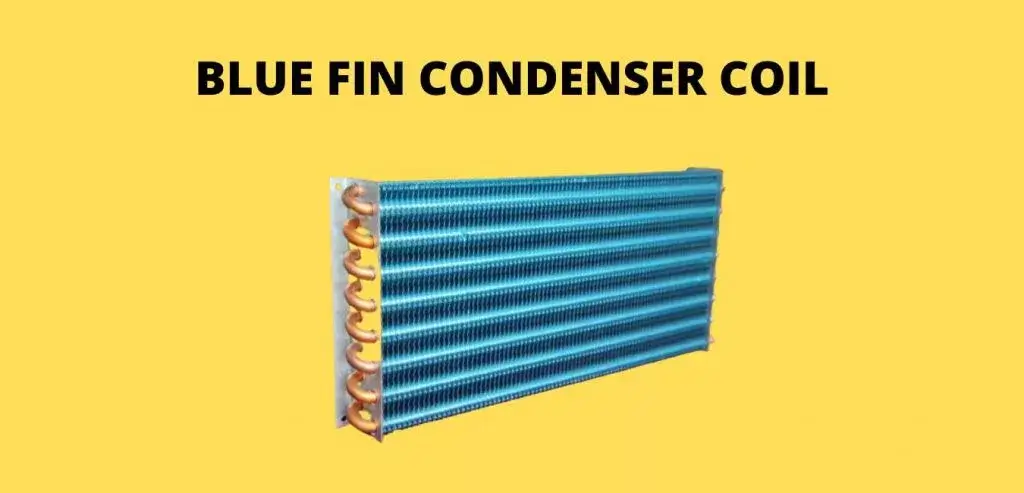
Gold Fin Technology:
This technology is somewhat similar to the above mentioned blue fin coating technology where the golden hydrophilic coating is pasted or applied over the coils for protection. Along with protecting the coils from the water effect corrosion, it helps in preventing rusting of the coils due to salts or dust and thus becomes useful not only in coastal areas but in other regions too.
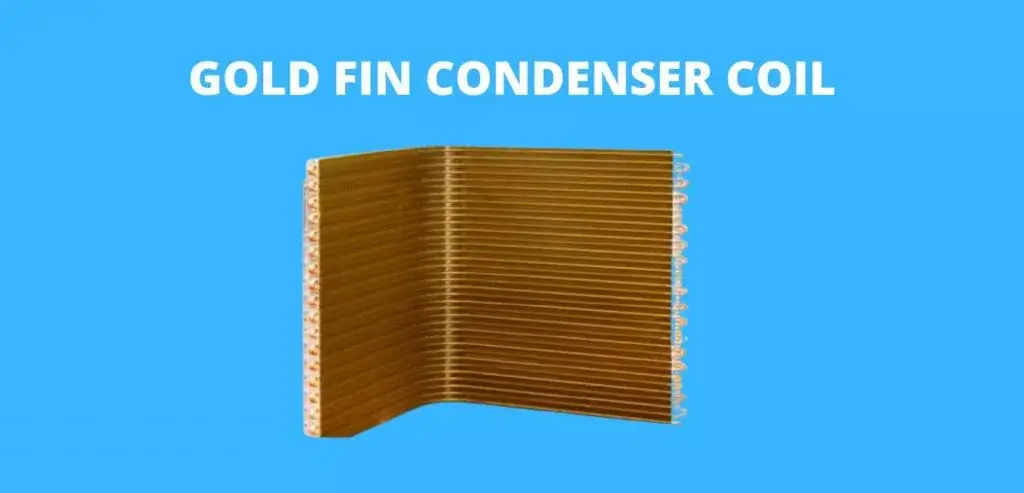
Few Important Tips on How Does AC Temperature Work?
- While talking about the cooling capacity in watts or tons of air conditioning (1 ton Air Conditioning = 12000 BTU/hr or 3517 cooling watts) we should be clear, more tonnage or bigger AC would help in faster cooling.
- Selecting the right size of AC is important. A bigger size AC working would cool faster, but if the compressor is of fixed speed, it would eventually end up overcooling the room which would lead to more power usage. On the other hand, Inverter AC working has good control over this cooling rate.
- Similarly, an undersized AC working would take more time to evacuate the heat & make the room cooler. Hence, would end up using more electricity.
- Usually, most ACs bring down the room temperature from a higher range say 30°C – 32°C to 25°C in a reasonable lesser time. 25°C is termed to be the most comfortable temperature for the human body. Cooling the room further below 25°C takes time because the flow rate of heat reduces greatly as the room temp reaches to comfortably cooler range. In order to achieve this at a faster pace, an oversized AC helps well.
Conclusion on How Does AC Temperature Work?
So, with this article, we tried to simplify the concept behind working of How Does AC Temperature Work?. We hope that this makes your basic understanding behind how does an Air Conditioner works quite simple. Do let us know your feedback/questions in the comments below and feel free to check out Air Conditioner FAQ | 21 Best Questionnaire.

